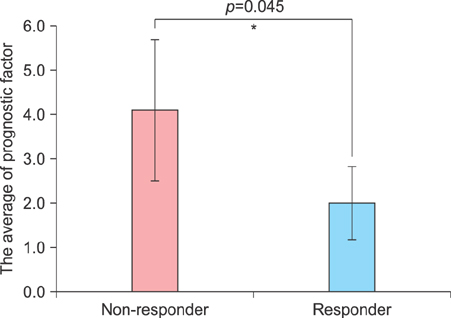Ann Dermatol.
2017 Dec;29(6):755-760. 10.5021/ad.2017.29.6.755.
Simvastatin/Ezetimibe Therapy for Recalcitrant Alopecia Areata: An Open Prospective Study of 14 Patients
- Affiliations
-
- 1Department of Dermatology, Kyung Hee University College of Medicine, Seoul, Korea. bellotte@hanmail.net
- KMID: 2395184
- DOI: http://doi.org/10.5021/ad.2017.29.6.755
Abstract
- BACKGROUND
Simvastatin belongs to the statin family, whose members have immunomodulatory activities. Ezetimibe have synergetic effects when co-administered with simvastatin. In several case reports, alopecia totalis and alopecia universalis were successfully treated with simvastatin/ezetimibe, suggesting that this combination could be a new efficient therapy for recalcitrant alopecia areata (AA).
OBJECTIVE
To verify the efficacy of the simvastatin/ezetimibe combination therapy for recalcitrant AA and investigate the relationship between various treatment responses and prognostic factors.
METHODS
This prospective open study was performed in patients with recalcitrant AA with the bald surface exceeding 75%. All patients took simvastatin (40 mg) and ezetimibe (10 mg) daily. The extent of hair regrowth expressed as percentage of the bald area was used to evaluate the effectiveness of the therapy.
RESULTS
Of 14 enrolled patients, 4 patients (28.6%) were judged as responders showing regrowth of 30% to 80% after 3 months of treatment. The mean age of onset in non-responders was significantly lower than in responders. The total score of prognostic factors, calculated as a sum of factors related to poor prognosis, was much lower in responders than in non-responders.
CONCLUSION
The remission rate in this study was unsatisfactory. However, since the recruited patients had not responded to any other treatments for AA, simvastatin/ezetimibe can still be considered as an alternative treatment for recalcitrant AA. The total scores of the prognostic factors were statistically different between responders and non-responders. These results can be used to predict the outcome of treatment with simvastatin/ezetimibe and anticipate prognosis.
Keyword
MeSH Terms
Figure
Reference
-
1. Kavak A, Yeşildal N, Parlak AH, Gökdemir G, Aydoğan I, Anul H, et al. Alopecia areata in Turkey: demographic and clinical features. J Eur Acad Dermatol Venereol. 2008; 22:977–981.
Article2. Nanda A, Al-Fouzan AS, Al-Hasawi F. Alopecia areata in children: a clinical profile. Pediatr Dermatol. 2002; 19:482–485.
Article3. Price VH. Alopecia areata: clinical aspects. J Invest Dermatol. 1991; 96:68S.
Article4. Safavi K. Prevalence of alopecia areata in the First National Health and Nutrition Examination Survey. Arch Dermatol. 1992; 128:702.
Article5. Fiedler VC. Alopecia areata. A review of therapy, efficacy, safety, and mechanism. Arch Dermatol. 1992; 128:1519–1529.
Article6. Gupta MA, Gupta AK. Depression and suicidal ideation in dermatology patients with acne, alopecia areata, atopic dermatitis and psoriasis. Br J Dermatol. 1998; 139:846–850.
Article7. Petukhova L, Duvic M, Hordinsky M, Norris D, Price V, Shimomura Y, et al. Genome-wide association study in alopecia areata implicates both innate and adaptive immunity. Nature. 2010; 466:113–117.
Article8. Robins DN. Case reports: alopecia universalis: hair growth following initiation of simvastatin and ezetimibe therapy. J Drugs Dermatol. 2007; 6:946–947.9. Ali A, Martin JM 4th. Hair growth in patients alopecia areata totalis after treatment with simvastatin and ezetimibe. J Drugs Dermatol. 2010; 9:62–64.10. Lattouf C, Jimenez JJ, Tosti A, Miteva M, Wikramanayake TC, Kittles C, et al. Treatment of alopecia areata with simvastatin/ezetimibe. J Am Acad Dermatol. 2015; 72:359–361.
Article11. Olsen EA, Hordinsky MK, Price VH, Roberts JL, Shapiro J, Canfield D, et al. Alopecia areata investigational assessment guidelines--Part II. National Alopecia Areata Foundation. J Am Acad Dermatol. 2004; 51:440–447.12. Tosti A, Bellavista S, Iorizzo M. Alopecia areata: a long term follow-up study of 191 patients. J Am Acad Dermatol. 2006; 55:438–441.
Article13. MacDonald Hull SP, Wood ML, Hutchinson PE, Sladden M, Messenger AG. British Association of Dermatologists. Guidelines for the management of alopecia areata. Br J Dermatol. 2003; 149:692–699.
Article14. Mach F. Immunosuppressive effects of statins. Atheroscler Suppl. 2002; 3:17–20.
Article15. Namazi MR. Statins: novel additions to the dermatologic arsenal? Exp Dermatol. 2004; 13:337–339.
Article16. Krysiak R, Zmuda W, Okopien B. The effect of ezetimibe, administered alone or in combination with simvastatin, on lymphocyte cytokine release in patients with elevated cholesterol levels. J Intern Med. 2012; 271:32–42.
Article17. Loi C, Starace M, Piraccini BM. Alopecia areata (AA) and treatment with simvastatin/ezetimibe: Experience of 20 patients. J Am Acad Dermatol. 2016; 74:e99–e100.
Article
- Full Text Links
- Actions
-
Cited
- CITED
-
- Close
- Share
- Similar articles
-
- Efficacy of Oral Tofacitinib in Patients with Alopecia Areata: Tofacitinib Was Ineffective for Recalcitrant Alopecia Totalis of a Long Duration
- Effect of ezetimibe and simvastatin combination in Korean hypercholesterolemic patients
- A Case of Congenitally Developed Alopecia Areata
- A Case of Alopecia Areata in a Patient taking Cyclosporine
- Superficial Cryotherapy of Alopecia Areata in Eyebrows




